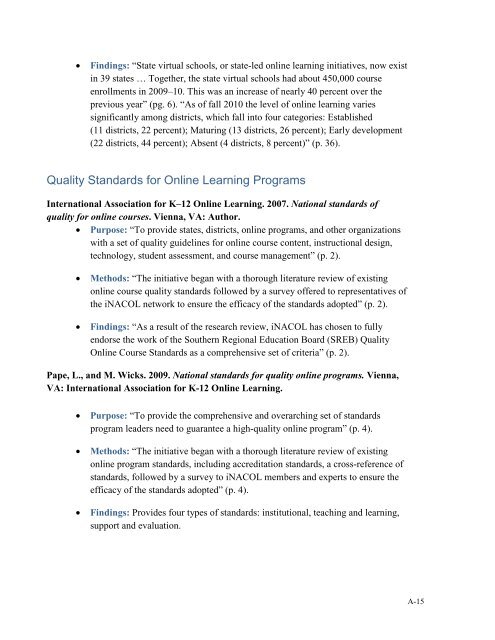Download PDF - SRI International
Download PDF - SRI International
Download PDF - SRI International
Create successful ePaper yourself
Turn your PDF publications into a flip-book with our unique Google optimized e-Paper software.
• Findings: “State virtual schools, or state-led online learning initiatives, now exist<br />
in 39 states … Together, the state virtual schools had about 450,000 course<br />
enrollments in 2009–10. This was an increase of nearly 40 percent over the<br />
previous year” (pg. 6). “As of fall 2010 the level of online learning varies<br />
significantly among districts, which fall into four categories: Established<br />
(11 districts, 22 percent); Maturing (13 districts, 26 percent); Early development<br />
(22 districts, 44 percent); Absent (4 districts, 8 percent)” (p. 36).<br />
Quality Standards for Online Learning Programs<br />
<strong>International</strong> Association for K–12 Online Learning. 2007. National standards of<br />
quality for online courses. Vienna, VA: Author.<br />
• Purpose: “To provide states, districts, online programs, and other organizations<br />
with a set of quality guidelines for online course content, instructional design,<br />
technology, student assessment, and course management” (p. 2).<br />
• Methods: “The initiative began with a thorough literature review of existing<br />
online course quality standards followed by a survey offered to representatives of<br />
the iNACOL network to ensure the efficacy of the standards adopted” (p. 2).<br />
• Findings: “As a result of the research review, iNACOL has chosen to fully<br />
endorse the work of the Southern Regional Education Board (SREB) Quality<br />
Online Course Standards as a comprehensive set of criteria” (p. 2).<br />
Pape, L., and M. Wicks. 2009. National standards for quality online programs. Vienna,<br />
VA: <strong>International</strong> Association for K-12 Online Learning.<br />
• Purpose: “To provide the comprehensive and overarching set of standards<br />
program leaders need to guarantee a high-quality online program” (p. 4).<br />
• Methods: “The initiative began with a thorough literature review of existing<br />
online program standards, including accreditation standards, a cross-reference of<br />
standards, followed by a survey to iNACOL members and experts to ensure the<br />
efficacy of the standards adopted” (p. 4).<br />
• Findings: Provides four types of standards: institutional, teaching and learning,<br />
support and evaluation.<br />
A-15
















